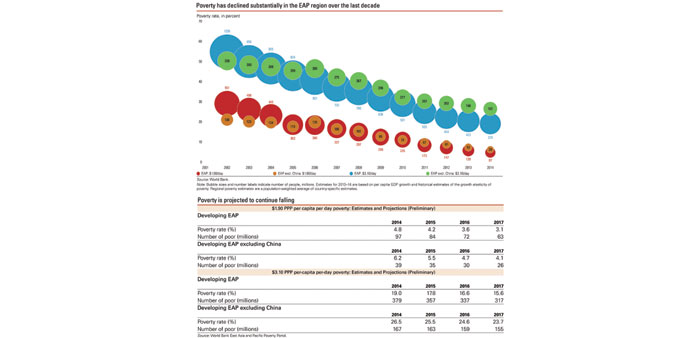The World Bank’s ‘Developing East Asia and Pacific’ region comprises China, Indonesia, Malaysia, Philippines, Thailand, Vietnam, Cambodia, Laos, Myanmar, Mongolia, Fiji, Papua New Guinea, Solomon Island, East Timor and a number of small Pacific island nations.
By Arno Maierbrugger
Gulf Times Correspondent
Bangkok
The World Bank in the latest of its half-yearly East Asia and Pacific Economic Update reports released on October 5 documents a rapid decline in poverty in the region over the past years and is confident that extreme, as well as moderate poverty will further shrink until 2017, albeit at a slower pace.
Despite the bank cut its 2015 and 2016 growth forecasts for developing East Asia and Pacific (EAP), saying the outlook was “clouded by the risk of a sharp slowdown in China” and “possible spillovers” from expected increases in US interest rates, this seems not to have a negative effect on falling poverty rates. Neither does the bank’s earlier decision to lift the international poverty line to $1.90 from $1.25 a day due to new data on differences in the cost of living across countries at purchasing power-adjusted exchange rates.
Data shows that extreme poverty in the EAP region has decreased sharply to 7.2% in 2012 from 29.1% in 2002, with projections indicating the poverty rate fell further to 4.8% in 2014. This translates into the number of people in developing East Asia living on less than $1.90 a day decreasing from 551mn in 2002 to 147mn in 2012 and to an estimated 97mn by 2014. Even excluding China, poverty declined rapidly from 21.1% in 2002 to 8.9% in 2012, the latest year with actual data for China, and is estimated to have set at 39mn in 2014.
However, people living above the extreme poverty line but below of what the World Bank defines as global moderate poverty line of $3.10 a day are estimated to have counted 379mn in 2014, and this income bracket is seen vulnerable to falling back into extreme poverty if economic indicators do not improve and risk slipping back to the bottom below $1.90 a day.
However, forecasts through 2017 suggest poverty in developing EAP will continue to decline, but at a slower rate. Extreme poverty is projected to decline further to 3.1% by 2017. This corresponds to around 63mn people in extreme poverty. Excluding China, poverty is projected to reach 4.1% by 2017 under the $1.90 a day threshold. But under the higher poverty line of $3.10 a day, the developing EAP region will still be home to more than 300mn “moderately poor” people by 2017, the World Bank assumes.
Worldwide, the number of people living in extreme poverty is likely to fall to under 10% of the global population by the end of 2015, the World Bank said earlier, providing fresh evidence that a quarter-century-long sustained reduction in poverty is moving the world closer to the historic goal of ending poverty by 2030.
According to World Bank Group President Jim Yong Kim, continued major reductions in poverty were due to strong growth rates in developing countries in recent years, investments in people’s education, health and social safety nets that helped keep people from falling back into poverty. But he clearly indicated that with slowing global economic growth and the considerable depth and breadth of remaining poverty, the goal to end extreme poverty will remain “a highly ambitious target.”
“It will be extraordinarily hard to end global poverty by 2030, especially in a period of slower global growth, volatile financial markets, conflicts, high youth unemployment and the growing impact of climate change,” Kim said.

